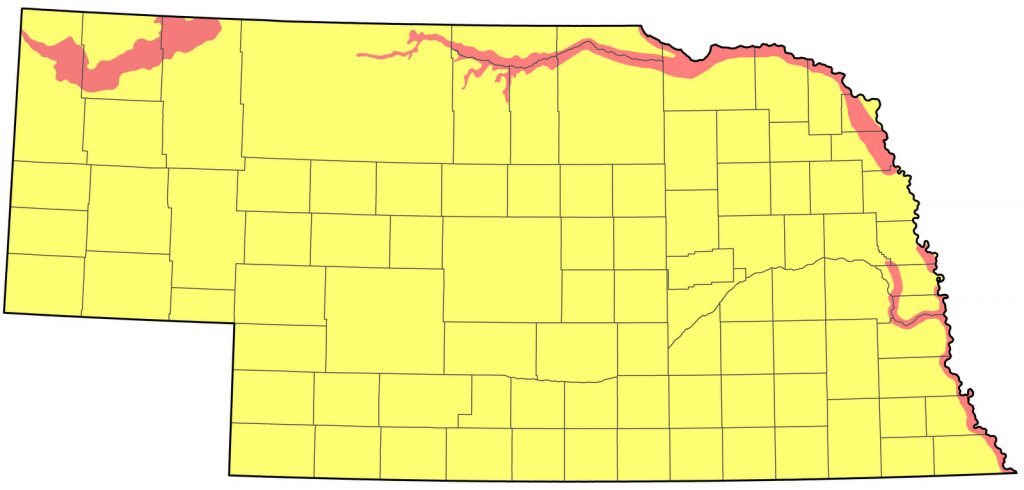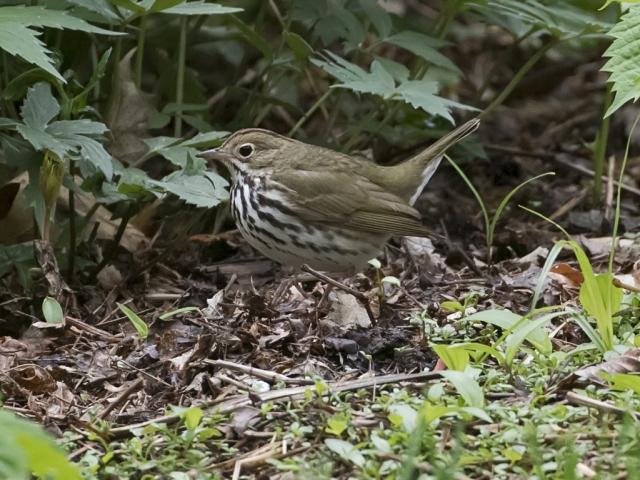Seiurus aurocapilla aurocapilla, S. a. cinereus
Status: Fairly common regular spring and fall migrant statewide. Fairly common regular breeder northwest, north and east.

Documentation: Specimen: UNSM ZM6885, May 1900 Sioux Co.
Taxonomy: Three subspecies are recognized (AviList 2025): cinereus, breeding in the Rocky Mountains from southern Alberta to Colorado and Nebraska, aurocapilla, breeding from eastern British Columbia to Nova Scotia and eastern US, and furvior, breeding on Newfoundland.
Subspecies cinereus breeds on the Pine Ridge in the northern Panhandle, and as far east as “central Nebraska (Camp Sheridan)” (AOU 1957). This locality is in extreme northwest Sheridan Co, some 19 kilometers (12 miles) south of the White River. Tordoff collected a singing male in Sioux Co on 19 Jul 1957, a specimen determined to be cinereus (Ford 1959).
Presumably birds breeding in eastern Nebraska along the Missouri River are aurocapillus, but where the breeding ranges of the two subspecies meet in central or eastern Nebraska is uncertain (AOU 1957).
Spring: Apr 26, 27, 27 <<<>>> Jun 1, 2, 2
An earlier date is 18 Apr 2023 Cass Co.
Last dates above are from non-breeding locations.
Later dates of probable migrants from presumed non-breeding locations are 6 Jun 2015 Lancaster Co, 9 Jun 2017 Saunders Co, 10 Jun 2014 Lincoln Co, 11 Jun 2001 Garfield Co, and 14 Jun 2019 Scotts Bluff Co. See Summer for discussion of later Jun and early Jul records.
Migration is from late Apr through late May.
- High counts: 58 in Sarpy Co 11 May 1996, including 44 at Fontenelle Forest, 14 at Indian Cave SP, Nemaha and Richardson Cos 14 May 2006, 14 at Fontenelle Forest 14 May 2016, 14 at Schramm Park SRA, Sarpy Co 15 May 2020, and 12 at Anderson Bridge WMA, Cherry Co 22 May 2024.
Summer: This species breeds in upland forests such as mature oak-hickory woodlands associated with bluffs of the Missouri and Niobrara River Valleys and in deciduous woodlands in the canyons of the Pine Ridge. It is also found in appropriate oak-hickory habitat associated with the lower Elkhorn River and the Platte River in Douglas and Sarpy Cos. Mollhoff (2022) noted an undated nest record for Nickerson, Dodge Co. Recent evidence suggests that breeding may be occurring at NNF Bessey, Thomas Co.
Ovenbirds breed throughout the Missouri River Valley in appropriate upland wooded habitat.
Westward along the eastern Niobrara River Valley, Brogie and Mossman (1983) found numerous singing males and territorial birds in the Niobrara Valley Preserve in 1982 and considered the species a “probable nester.” There are several summer reports for these counties as well as Holt and Cherry Cos. Mollhoff (2001) showed breeding reports west to central Cherry Co; by 2016 (Mollhoff 2016), the range limit was unchanged although there were more westerly reports. Recent additional reports from that area are of four at Anderson Bridge WMA 19 Jun 2014 and one at the Road 16F Niobrara River crossing 14 Jun 2016. The only report shown by Mollhoff (2016) between central Cherry Co and the Pine Ridge along the Niobrara River Valley was a single “Possible” report along the Niobrara River in eastern Sheridan Co.
On the Pine Ridge, Mollhoff (2001) showed breeding reports only in Sioux and Dawes Cos, but by 2016 (Mollhoff 2016), breeding was confirmed in northwest Sheridan Co, suggesting eastward expansion of the Pine Ridge range. Rosche (1982) described Ovenbird as a “fairly common summer resident,” breeding in Sioux and Dawes Cos. Although it is usually accepted that Ovenbird requires rather extensive woodland for breeding, the western race cinereus, breeding on the Pine Ridge, may be adapted to woodlands of sharply limited extent. Andrews and Righter (1992) noted that in Colorado it breeds in “foothill riparian thickets.” One summered in such habitat at Wind Springs Ranch, southern Sioux Co, in 2010, although no evidence of breeding was noted.
In the Loup drainage there are recent summer reports of good numbers at NNF Bessey, including careful counts 4 Jul 2015 which tallied 11 birds, seven there 18 Jun 2014, and eight on 29 May 2017. Similar reports have continued, with best counts 12 at two locations 6 Jun 2022, and 12 there 7 Jun 2024. There is a previous report there 30 Jun-2 Jul 1993 (Bray 1994). Although breeding seems apparent, it has not been confirmed as of summer 2025.
In the Platte River Valley, there are several records in the Keith Co area; Rosche (1994) cited reports from Garden and Keith Cos including one on 15 Jul, and Brown et al (1996) noted that while there was no evidence for nesting in the Lake Ogallala area, 12 birds had been netted there 2 Jul-7 Aug, all with brood patches. Brown and Brown (2001) reported one on 29 Jun (year not given) in the Keith Co area, and one was at Lake Ogallala 16 Jul 2016. There are several summer records of singing male(s) at or near Chester Island WMA, Lincoln Co, including five records 17 May-13 Jun 2009, 19 May 2011, 15 Jul 2012, two on 1 Jul 2013, and two on 1 Jul 2014.
There are several late Jun-early Jul records away from known breeding locations; the status of these birds is not known, although some may be attempting breeding: 16 Jun (2) Saunders Co, 19 Jun 2002 singing Merrick Co, 21 Jun 2017 Webster Co, 23 Jun 2010 Gage Co, 1 Jul 2017 Rock Creek SRA, Jefferson Co, 6 Jul 2020 Jefferson Co, 9 Jul 2018 Nuckolls Co, 12 Jul 2022 Grove Lake WMA, Antelope Co, and 14 Jul 2011 Platte Co.
- Breeding phenology:
Eggs: 26 May- 14 Jun (Mollhoff 2022)
Nestlings: 1-18 Jun - Fledglings: 17 Jul
- High counts: 200 in the Niobrara Valley Preserve, Brown Co 17 Jun 1995, 40 there 28 Jun 1997, 14 at Gilbert-Baker WMA, Sioux Co 9 Jun 2023, and 8 at Ashford Scout Camp, Dakota Co 3 Jul 1999.
Fall: Aug 4, 4, 5 <<<>>> Sep 26, 27, 28
Early dates above are away from known breeding areas. Earlier dates of probable migrants are 26 Jul 2012 Lincoln Co, and 29 Jul 2010 Lincoln Co.
Later dates are 30 Sep 2015 Douglas Co, 1 Oct 2014 Sarpy Co, 3 Oct 2018 Douglas Co, and 23 Oct 2005 Elkhorn, Douglas Co, 23 Oct 2013 Lancaster Co, 26 Oct 1991 McPherson Co (Grzybowski 1992), and 11 Nov 2000 Lincoln, Lancaster Co (Jorgensen 2002).
A few reports in mid-Jul (see Summer) from areas where breeding is not known may be of early departing adults, mostly males. According to Porneluzi et al (2020), “In Michigan, adults leave the breeding area as soon as the young can care for themselves. Immature birds remain on the breeding grounds until late September”. Time from egg laying to independence in Michigan indicates that adults would begin leaving around 20 Jul (Porneluzi et al 2020).
Migration peaks in late Aug and early Sep, and ends by early Oct.
- High counts: 5 at Lake Ogallala 26 Aug and 3 Sep 2006, 5 at Chadron SP, Dawes Co 29 Aug 2017, 3 at Homestead NM, Gage Co 17 Aug 2016, and 3 at Rock Creek SRA, Dundy Co 29 Aug 2021.
Images
Abbreviations
NNF: Nebraska National Forest
NM: National Monument
NWR: National Wildlife Refuge
SP: State Park
SRA: State Recreation Area
UNSM: University of Nebraska State Museum
WMA: Wildlife Management Area (State)
Literature Cited
Andrews, R., and R. Righter. 1992. Colorado birds. Denver Museum of Natural History, Denver, Colorado, USA.
American Ornithologists’ Union [AOU]. 1957. The AOU Check-list of North American birds, 5th ed. Port City Press, Baltimore, Maryland, USA.
AviList Core Team, 2025. AviList: The Global Avian Checklist, v2025. https://doi.org/10.2173/avilist.v2025.
Bray, T.E. 1994. Habitat utilization by birds in a man-made forest in the Nebraska Sandhills. M.S. thesis, University of Nebraska-Omaha.
Brogie, M.A., and M.J. Mossman. 1983. Spring and summer birds of the Niobrara Valley Preserve, Nebraska: An annotated checklist. NBR 51: 44-51.
Brown, C.R., M.B. Brown, P.A. Johnsgard, J. Kren, and W.C. Scharf. 1996. Birds of the Cedar Point Biological Station area, Keith and Garden Counties, Nebraska: Seasonal occurrence and breeding data. Transactions of the Nebraska Academy of Sciences 23: 91-108.
Brown, C.R., and M.B. Brown. 2001. Birds of the Cedar Point Biological Station. Occasional Papers of the Cedar Point Biological Station, No. 1.
Ford, N.L. 1959. Notes on summer birds of western Nebraska. NBR 27: 6-12.
Grzybowski, J.A. 1992. Southern Great Plains Region. American Birds 46: 113-117.
Jorgensen, J.G. 2002. 2002 (sic; =2000). (12th) Report of the NOU Records Committee. NBR 70: 84-90. Mollhoff, W.J. 2001. The Nebraska Breeding Bird Atlas 1984-1989. Nebraska Ornithologists’ Union Occasional Papers No. 7. Nebraska Game and Parks Commission, Lincoln, Nebraska, USA.
Mollhoff, W.J. 2001. The Nebraska Breeding Bird Atlas 1984-1989. Nebraska Ornithologists’ Union Occasional Papers No. 7. Nebraska Game and Parks Commission, Lincoln, Nebraska, USA.
Mollhoff, W.J. 2016. The Second Nebraska Breeding Bird Atlas. Bull. Univ. Nebraska State Museum Vol 29. University of Nebraska State Museum, Lincoln, Nebraska, USA.
Mollhoff, W.J. 2022. Nest records of Nebraska birds. Nebraska Ornithologists’ Union Occasional Paper Number 9.
Porneluzi, P., M.A. Van Horn, and T.M. Donovan. 2020. Ovenbird (Seiurus aurocapilla), version 1.0. In Birds of the World (A. F. Poole, Editor). Cornell Lab of Ornithology, Ithaca, NY, USA. https://doi.org/10.2173/bow.ovenbi1.01.
Rosche, R.C. 1982. Birds of northwestern Nebraska and southwestern South Dakota, an annotated checklist. Cottonwood Press, Crawford, Nebraska, USA.
Rosche, R.C. 1994. Birds of the Lake McConaughy area and the North Platte River valley, Nebraska. Published by the author, Chadron, Nebraska, USA.
Recommended Citation
Silcock, W.R., and J.G. Jorgensen. 2025. Ovenbird (Seiurus aurocapilla). In Birds of Nebraska — Online. www.BirdsofNebraska.org
Birds of Nebraska – Online
Updated 31 Aug 2025

